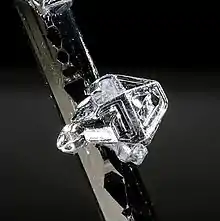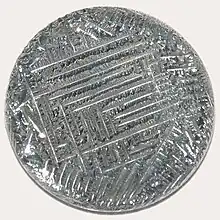 | ||||||||||||||||||||||||||||||||||||||||||||||||||||||||||||||||||
| Tellurium | ||||||||||||||||||||||||||||||||||||||||||||||||||||||||||||||||||
|---|---|---|---|---|---|---|---|---|---|---|---|---|---|---|---|---|---|---|---|---|---|---|---|---|---|---|---|---|---|---|---|---|---|---|---|---|---|---|---|---|---|---|---|---|---|---|---|---|---|---|---|---|---|---|---|---|---|---|---|---|---|---|---|---|---|---|
| Pronunciation | /tɛˈljʊəriəm/ | |||||||||||||||||||||||||||||||||||||||||||||||||||||||||||||||||
| Appearance | silvery lustrous gray (crystalline), brown-black powder (amorphous) | |||||||||||||||||||||||||||||||||||||||||||||||||||||||||||||||||
| Standard atomic weight Ar°(Te) | ||||||||||||||||||||||||||||||||||||||||||||||||||||||||||||||||||
| ||||||||||||||||||||||||||||||||||||||||||||||||||||||||||||||||||
| Tellurium in the periodic table | ||||||||||||||||||||||||||||||||||||||||||||||||||||||||||||||||||
| ||||||||||||||||||||||||||||||||||||||||||||||||||||||||||||||||||
| Atomic number (Z) | 52 | |||||||||||||||||||||||||||||||||||||||||||||||||||||||||||||||||
| Group | group 16 (chalcogens) | |||||||||||||||||||||||||||||||||||||||||||||||||||||||||||||||||
| Period | period 5 | |||||||||||||||||||||||||||||||||||||||||||||||||||||||||||||||||
| Block | p-block | |||||||||||||||||||||||||||||||||||||||||||||||||||||||||||||||||
| Electron configuration | [Kr] 4d10 5s2 5p4 | |||||||||||||||||||||||||||||||||||||||||||||||||||||||||||||||||
| Electrons per shell | 2, 8, 18, 18, 6 | |||||||||||||||||||||||||||||||||||||||||||||||||||||||||||||||||
| Physical properties | ||||||||||||||||||||||||||||||||||||||||||||||||||||||||||||||||||
| Phase at STP | solid | |||||||||||||||||||||||||||||||||||||||||||||||||||||||||||||||||
| Melting point | 722.66 K (449.51 °C, 841.12 °F) | |||||||||||||||||||||||||||||||||||||||||||||||||||||||||||||||||
| Boiling point | 1261 K (988 °C, 1810 °F) | |||||||||||||||||||||||||||||||||||||||||||||||||||||||||||||||||
| Density (near r.t.) | 6.24 g/cm3 | |||||||||||||||||||||||||||||||||||||||||||||||||||||||||||||||||
| when liquid (at m.p.) | 5.70 g/cm3 | |||||||||||||||||||||||||||||||||||||||||||||||||||||||||||||||||
| Heat of fusion | 17.49 kJ/mol | |||||||||||||||||||||||||||||||||||||||||||||||||||||||||||||||||
| Heat of vaporization | 114.1 kJ/mol | |||||||||||||||||||||||||||||||||||||||||||||||||||||||||||||||||
| Molar heat capacity | 25.73 J/(mol·K) | |||||||||||||||||||||||||||||||||||||||||||||||||||||||||||||||||
Vapor pressure
| ||||||||||||||||||||||||||||||||||||||||||||||||||||||||||||||||||
| Atomic properties | ||||||||||||||||||||||||||||||||||||||||||||||||||||||||||||||||||
| Oxidation states | −2, −1, 0, +1, +2, +3, +4, +5, +6 (a mildly acidic oxide) | |||||||||||||||||||||||||||||||||||||||||||||||||||||||||||||||||
| Electronegativity | Pauling scale: 2.1 | |||||||||||||||||||||||||||||||||||||||||||||||||||||||||||||||||
| Ionization energies |
| |||||||||||||||||||||||||||||||||||||||||||||||||||||||||||||||||
| Atomic radius | empirical: 140 pm | |||||||||||||||||||||||||||||||||||||||||||||||||||||||||||||||||
| Covalent radius | 138±4 pm | |||||||||||||||||||||||||||||||||||||||||||||||||||||||||||||||||
| Van der Waals radius | 206 pm | |||||||||||||||||||||||||||||||||||||||||||||||||||||||||||||||||
| Other properties | ||||||||||||||||||||||||||||||||||||||||||||||||||||||||||||||||||
| Natural occurrence | primordial | |||||||||||||||||||||||||||||||||||||||||||||||||||||||||||||||||
| Crystal structure | trigonal[2] | |||||||||||||||||||||||||||||||||||||||||||||||||||||||||||||||||
| Speed of sound thin rod | 2610 m/s (at 20 °C) | |||||||||||||||||||||||||||||||||||||||||||||||||||||||||||||||||
| Thermal expansion | 18 µm/(m⋅K)[3] (at r.t.) | |||||||||||||||||||||||||||||||||||||||||||||||||||||||||||||||||
| Thermal conductivity | 1.97–3.38 W/(m⋅K) | |||||||||||||||||||||||||||||||||||||||||||||||||||||||||||||||||
| Magnetic ordering | diamagnetic[4] | |||||||||||||||||||||||||||||||||||||||||||||||||||||||||||||||||
| Molar magnetic susceptibility | −39.5×10−6 cm3/mol (298 K)[5] | |||||||||||||||||||||||||||||||||||||||||||||||||||||||||||||||||
| Young's modulus | 43 GPa | |||||||||||||||||||||||||||||||||||||||||||||||||||||||||||||||||
| Shear modulus | 16 GPa | |||||||||||||||||||||||||||||||||||||||||||||||||||||||||||||||||
| Bulk modulus | 65 GPa | |||||||||||||||||||||||||||||||||||||||||||||||||||||||||||||||||
| Mohs hardness | 2.25 | |||||||||||||||||||||||||||||||||||||||||||||||||||||||||||||||||
| Brinell hardness | 180–270 MPa | |||||||||||||||||||||||||||||||||||||||||||||||||||||||||||||||||
| CAS Number | 13494-80-9 | |||||||||||||||||||||||||||||||||||||||||||||||||||||||||||||||||
| History | ||||||||||||||||||||||||||||||||||||||||||||||||||||||||||||||||||
| Naming | after Roman Tellus, deity of the Earth | |||||||||||||||||||||||||||||||||||||||||||||||||||||||||||||||||
| Discovery | Franz-Joseph Müller von Reichenstein (1782) | |||||||||||||||||||||||||||||||||||||||||||||||||||||||||||||||||
| First isolation | Martin Heinrich Klaproth | |||||||||||||||||||||||||||||||||||||||||||||||||||||||||||||||||
| Isotopes of tellurium | ||||||||||||||||||||||||||||||||||||||||||||||||||||||||||||||||||
| ||||||||||||||||||||||||||||||||||||||||||||||||||||||||||||||||||
Tellurium is a chemical element; it has symbol Te and atomic number 52. It is a brittle, mildly toxic, rare, silver-white metalloid. Tellurium is chemically related to selenium and sulfur, all three of which are chalcogens. It is occasionally found in its native form as elemental crystals. Tellurium is far more common in the Universe as a whole than on Earth. Its extreme rarity in the Earth's crust, comparable to that of platinum, is due partly to its formation of a volatile hydride that caused tellurium to be lost to space as a gas during the hot nebular formation of Earth.[8]
Tellurium-bearing compounds were first discovered in 1782 in a gold mine in Kleinschlatten, Transylvania (now Zlatna, Romania) by Austrian mineralogist Franz-Joseph Müller von Reichenstein, although it was Martin Heinrich Klaproth who named the new element in 1798 after the Latin tellus 'earth'. Gold telluride minerals are the most notable natural gold compounds. However, they are not a commercially significant source of tellurium itself, which is normally extracted as a by-product of copper and lead production.
Commercially, the primary use of tellurium is CdTe solar panels and thermoelectric devices. A more traditional application in copper (tellurium copper) and steel alloys, where tellurium improves machinability, also consumes a considerable portion of tellurium production. Tellurium is considered a technology-critical element.[9]
Tellurium has no biological function, although fungi can use it in place of sulfur and selenium in amino acids such as tellurocysteine and telluromethionine.[10] In humans, tellurium is partly metabolized into dimethyl telluride, (CH3)2Te, a gas with a garlic-like odor exhaled in the breath of victims of tellurium exposure or poisoning.
Characteristics
Physical properties
Tellurium has two allotropes, crystalline and amorphous. When crystalline, tellurium is silvery-white with a metallic luster. The crystals are trigonal and chiral (space group 152 or 154 depending on the chirality), like the gray form of selenium. It is a brittle and easily pulverized metalloid. Amorphous tellurium is a black-brown powder prepared by precipitating it from a solution of tellurous acid or telluric acid (Te(OH)6).[11] Tellurium is a semiconductor that shows greater electrical conductivity in certain directions depending on atomic alignment; the conductivity increases slightly when exposed to light (photoconductivity).[12] When molten, tellurium is corrosive to copper, iron, and stainless steel. Of the chalcogens (oxygen-family elements), tellurium has the highest melting and boiling points, at 722.66 K (449.51 °C) and 1,261 K (988 °C), respectively.[13]
Chemical properties
Crystalline tellurium consists of parallel helical chains of Te atoms, with three atoms per turn. This gray material resists oxidation by air and is not volatile.[14]
Isotopes
Naturally occurring tellurium has eight isotopes. Six of those isotopes, 120Te, 122Te, 123Te, 124Te, 125Te, and 126Te, are stable. The other two, 128Te and 130Te, are slightly radioactive,[15][16][17] with extremely long half-lives, including 2.2 × 1024 years for 128Te. This is the longest known half-life among all radionuclides[18] and is about 160 trillion (1012) times the age of the known universe.
A further 31 artificial radioisotopes of tellurium are known, with atomic masses ranging from 104 to 142 and with half-lives of 19 days or less. Also, 17 nuclear isomers are known, with half-lives up to 154 days. Except for beryllium-8 and beta-delayed alpha emission branches in some lighter nuclides, tellurium (104Te to 109Te) is the second lightest element with isotopes known to undergo alpha decay, antimony being the lightest.[15]
The atomic mass of tellurium (127.60 g·mol−1) exceeds that of iodine (126.90 g·mol−1), the next element in the periodic table.[19]
Occurrence
With an abundance in the Earth's crust comparable to that of platinum (about 1 µg/kg), tellurium is one of the rarest stable solid elements.[20] In comparison, even thulium, the rarest of the stable lanthanides has crystal abundances of 500 µg/kg (see Abundance of the chemical elements).[21]
This rarity of tellurium in the Earth's crust is not a reflection of its cosmic abundance. Tellurium is more abundant than rubidium in the cosmos, though rubidium is 10,000 times more abundant in the Earth's crust. The rarity of tellurium on Earth is thought to be caused by conditions during preaccretional sorting in the solar nebula, when the stable form of certain elements, in the absence of oxygen and water, was controlled by the reductive power of free hydrogen. Under this scenario, certain elements that form volatile hydrides, such as tellurium, were severely depleted through the evaporation of these hydrides. Tellurium and selenium are the heavy elements most depleted by this process.[8]
Tellurium is sometimes found in its native (i.e., elemental) form, but is more often found as the tellurides of gold such as calaverite and krennerite (two different polymorphs of AuTe2), petzite, Ag3AuTe2, and sylvanite, AgAuTe4. The town of Telluride, Colorado, was named in the hope of a strike of gold telluride (which never materialized, though gold metal ore was found). Gold itself is usually found uncombined, but when found as a chemical compound, it is often combined with tellurium.[22]
Although tellurium is found with gold more often than in uncombined form, it is found even more often combined as tellurides of more common metals (e.g. melonite, NiTe2). Natural tellurite and tellurate minerals also occur, formed by the oxidation of tellurides near the Earth's surface. In contrast to selenium, tellurium does not usually replace sulfur in minerals because of the great difference in ion radii. Thus, many common sulfide minerals contain substantial quantities of selenium and only traces of tellurium.[23]
In the gold rush of 1893, miners in Kalgoorlie discarded a pyritic material as they searched for pure gold, and it was used to fill in potholes and build sidewalks. In 1896, that tailing was discovered to be calaverite, a telluride of gold, and it sparked a second gold rush that included mining the streets.[24]
In 2023 astronomers detected the creation of tellurium during collision between two neutron stars.[25]
History
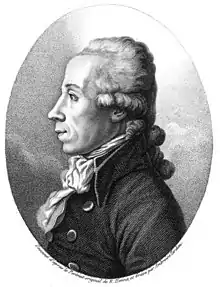
Tellurium (Latin tellus meaning "earth") was discovered in the 18th century in a gold ore from the mines in Kleinschlatten (today Zlatna), near today's city of Alba Iulia, Romania. This ore was known as "Faczebajer weißes blättriges Golderz" (white leafy gold ore from Faczebaja, German name of Facebánya, now Fața Băii in Alba County) or antimonalischer Goldkies (antimonic gold pyrite), and according to Anton von Rupprecht, was Spießglaskönig (argent molybdique), containing native antimony.[26] In 1782 Franz-Joseph Müller von Reichenstein, who was then serving as the Austrian chief inspector of mines in Transylvania, concluded that the ore did not contain antimony but was bismuth sulfide.[27] The following year, he reported that this was erroneous and that the ore contained mostly gold and an unknown metal very similar to antimony. After a thorough investigation that lasted three years and included more than fifty tests, Müller determined the specific gravity of the mineral and noted that when heated, the new metal gives off a white smoke with a radish-like odor; that it imparts a red color to sulfuric acid; and that when this solution is diluted with water, it has a black precipitate. Nevertheless, he was not able to identify this metal and gave it the names aurum paradoxum (paradoxical gold) and metallum problematicum (problem metal), because it did not exhibit the properties predicted for antimony.[28][29][30]
In 1789, a Hungarian scientist, Pál Kitaibel, discovered the element independently in an ore from Deutsch-Pilsen that had been regarded as argentiferous molybdenite, but later he gave the credit to Müller. In 1798, it was named by Martin Heinrich Klaproth, who had earlier isolated it from the mineral calaverite.[31][29][30][32]
In the early 1920s, Thomas Midgley Jr. found tellurium prevented engine knocking when added to fuel, but ruled it out due to the difficult-to-eradicate smell. Midgley went on to discover and popularize the use of tetraethyl lead.[33]
The 1960s brought an increase in thermoelectric applications for tellurium (as bismuth telluride), and in free-machining steel alloys, which became the dominant use. These applications were overtaken by the growing importance of CdTe in thin-film solar cells in the 2000s.[9]
Production
Most Te (and Se) is obtained from porphyry copper deposits, where it occurs in trace amounts.[34] The element is recovered from anode sludges from the electrolytic refining of blister copper. It is a component of dusts from blast furnace refining of lead. Treatment of 1000 tons of copper ore yields approximately one kilogram (2.2 pounds) of tellurium.[35]
The anode sludges contain the selenides and tellurides of the noble metals in compounds with the formula M2Se or M2Te (M = Cu, Ag, Au). At temperatures of 500 °C the anode sludges are roasted with sodium carbonate under air. The metal ions are reduced to the metals, while the telluride is converted to sodium tellurite.[36]
Tellurites can be leached from the mixture with water and are normally present as hydrotellurites HTeO3− in solution. Selenites are also formed during this process, but they can be separated by adding sulfuric acid. The hydrotellurites are converted into the insoluble tellurium dioxide while the selenites stay in solution.[36]
3 + OH− + H2SO4 → TeO2 + SO2−
4 + 2 H2O
The metal is produced from the oxide (reduced) either by electrolysis or by reacting the tellurium dioxide with sulfur dioxide in sulfuric acid.[36]
4 + 4 H+
Commercial-grade tellurium is usually marketed as 200-mesh powder but is also available as slabs, ingots, sticks, or lumps. The year-end price for tellurium in 2000 was US$30 per kilogram. In recent years, the tellurium price was driven up by increased demand and limited supply, reaching as high as US$220 per pound in 2006.[37][38] The average annual price for 99.99%-pure tellurium increased from $38 per kilogram in 2017 to $74 per kilogram in 2018.[9] Despite the expectation that improved production methods will double production, the United States Department of Energy (DoE) anticipates a supply shortfall of tellurium by 2025.[39]
In the 2020s, China produced ca. 50% of world's tellurium and was the only country that mined Te as the main target rather than a by-product. This dominance was driven by the rapid expansion of solar cell industry in China. In 2022, the largest Te providers by volume were China (340 tonnes), Russia (80 t), Japan (70 t), Canada (50 t), Uzbekistan (50 t), Sweden (40 t) and the United States (no official data).[40]
Compounds
Tellurium belongs to the chalcogen (group 16) family of elements on the periodic table, which also includes oxygen, sulfur, selenium and polonium: Tellurium and selenium compounds are similar. Tellurium exhibits the oxidation states −2, +2, +4 and +6, with +4 being most common.[11]
Tellurides
Reduction of Te metal produces the tellurides and polytellurides, Ten2−. The −2 oxidation state is exhibited in binary compounds with many metals, such as zinc telluride, ZnTe, produced by heating tellurium with zinc.[41] Decomposition of ZnTe with hydrochloric acid yields hydrogen telluride (H
2Te), a highly unstable analogue of the other chalcogen hydrides, H
2O, H
2S and H
2Se:[42]
2 + H
2Te
Halides
The +2 oxidation state is exhibited by the dihalides, TeCl
2, TeBr
2 and TeI
2. The dihalides have not been obtained in pure form,[43]: 274 although they are known decomposition products of the tetrahalides in organic solvents, and the derived tetrahalotellurates are well-characterized:
2 + 2 X−
→ TeX2−
4
where X is Cl, Br, or I. These anions are square planar in geometry.[43]: 281 Polynuclear anionic species also exist, such as the dark brown Te
2I2−
6,[43]: 283 and the black Te
4I2−
14.[43]: 285
With fluorine Te forms the mixed-valence Te
2F
4 and TeF
6. In the +6 oxidation state, the –OTeF
5 structural group occurs in a number of compounds such as HOTeF
5, B(OTeF
5)
3, Xe(OTeF
5)
2, Te(OTeF
5)
4 and Te(OTeF
5)
6.[44] The square antiprismatic anion TeF2−
8 is also attested.[36] The other halogens do not form halides with tellurium in the +6 oxidation state, but only tetrahalides (TeCl
4, TeBr
4 and TeI
4) in the +4 state, and other lower halides (Te
3Cl
2, Te
2Cl
2, Te
2Br
2, Te
2I and two forms of TeI). In the +4 oxidation state, halotellurate anions are known, such as TeCl2−
6 and Te
2Cl2−
10. Halotellurium cations are also attested, including TeI+
3, found in TeI
3AsF
6.[45]
Oxocompounds
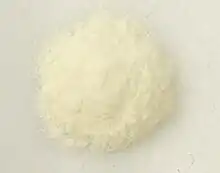
Tellurium monoxide was first reported in 1883 as a black amorphous solid formed by the heat decomposition of TeSO
3 in vacuum, disproportionating into tellurium dioxide, TeO
2 and elemental tellurium upon heating.[46][47] Since then, however, existence in the solid phase is doubted and in dispute, although it is known as a vapor fragment; the black solid may be merely an equimolar mixture of elemental tellurium and tellurium dioxide.[48]
Tellurium dioxide is formed by heating tellurium in air, where it burns with a blue flame.[41] Tellurium trioxide, β-TeO
3, is obtained by thermal decomposition of Te(OH)
6. The other two forms of trioxide reported in the literature, the α- and γ- forms, were found not to be true oxides of tellurium in the +6 oxidation state, but a mixture of Te4+
, OH−
and O−
2.[49] Tellurium also exhibits mixed-valence oxides, Te
2O
5 and Te
4O
9.[49]
The tellurium oxides and hydrated oxides form a series of acids, including tellurous acid (H
2TeO
3), orthotelluric acid (Te(OH)
6) and metatelluric acid ((H
2TeO
4)
n).[48] The two forms of telluric acid form tellurate salts containing the TeO2–
4 and TeO6−
6 anions, respectively. Tellurous acid forms tellurite salts containing the anion TeO2−
3.[50]
Zintl cations
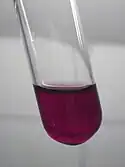
4
When tellurium is treated with concentrated sulfuric acid, the result is a red solution of the Zintl ion, Te2+
4.[51] The oxidation of tellurium by AsF
5 in liquid SO
2 produces the same square planar cation, in addition to the trigonal prismatic, yellow-orange Te4+
6:[36]
5 → Te2+
4(AsF−
6)
2 + AsF
3
5 → Te4+
6(AsF−
6)
4 + 2 AsF
3
Other tellurium Zintl cations include the polymeric Te2+
7 and the blue-black Te2+
8, consisting of two fused 5-membered tellurium rings. The latter cation is formed by the reaction of tellurium with tungsten hexachloride:[36]
6 → Te2+
8(WCl−
6)
2
Interchalcogen cations also exist, such as Te
2Se2+
6 (distorted cubic geometry) and Te
2Se2+
8. These are formed by oxidizing mixtures of tellurium and selenium with AsF
5 or SbF
5.[36]
Organotellurium compounds
Tellurium does not readily form analogues of alcohols and thiols, with the functional group –TeH, that are called tellurols. The –TeH functional group is also attributed using the prefix tellanyl-.[52] Like H2Te, these species are unstable with respect to loss of hydrogen. Telluraethers (R–Te–R) are more stable, as are telluroxides.[53]
Tritelluride quantum materials
Recently, physicists and materials scientists have been discovering unusual quantum properties associated with layered compounds composed of tellurium that's combined with certain rare-earth elements, as well as yttrium (Y).[54]
These novel materials have the general formula of R Te3, where "R " represents a rare-earth lanthanide (or Y), with the full family consisting of R = Y, La, Ce, Pr, Nd, Sm, Gd, Tb, Dy, Ho, Er & Tm (not yet observed are compounds containing Pm, Eu, Yb & Lu). These materials have a two-dimensional character within an orthorhombic crystal structure, with slabs of R Te separated by sheets of pure Te.[54]
It is thought that this 2-D layered structure is what leads to a number of interesting quantum features, such as charge-density waves, high carrier mobility, superconductivity under specific conditions, and other peculiar properties whose natures are only now emerging.[54]
For example, in 2022, a small group of physicists at Boston College in Massachusetts led an international team that used optical methods to demonstrate a novel axial mode of a Higgs-like particle in R Te3 compounds that incorporate either of two rare-earth elements (R = La, Gd).[55] This long-hypothesized, axial, Higgs-like particle also shows magnetic properties and may serve as a candidate for dark matter.[56]
Applications
In 2022, the major applications of tellurium were thin-film solar cells (40%), thermoelectrics (30%), metallurgy (15%), and rubber (5%), with the first two applications experiencing a rapid increase owing to the worldwide tendency of reducing dependence on the fossil fuel.[40][9] In metallurgy, tellurium is added to iron, stainless steel, copper, and lead alloys. It improves the machinability of copper without reducing its high electrical conductivity. It increases resistance to vibration and fatigue of lead and stabilizes various carbides and in malleable iron.[9]
Heterogeneous catalysis
Tellurium oxides are components of commercial oxidation catalysts. Te-containing catalysts are used for the ammoxidation route to acrylonitrile (CH2=CH–C≡N):[57]
Related catalysts are used in the production of tetramethylene glycol:
Niche
- Synthetic rubber vulcanized with tellurium shows mechanical and thermal properties that in some ways are superior to sulfur-vulcanized materials.[58][57]
- Tellurium compounds are specialized pigments for ceramics.[22]
- Selenides and tellurides greatly increase the optical refraction of glass widely used in glass optical fibers for telecommunications.[59][60]
- Mixtures of selenium and tellurium are used with barium peroxide as an oxidizer in the delay powder of electric blasting caps.[61]
- Neutron bombardment of tellurium is the most common way to produce iodine-131.[62] This in turn is used to treat some thyroid conditions, and as a tracer compound in hydraulic fracturing, among other applications.
Semiconductor and electronic
_the_detector_plane.jpg.webp)
Cadmium telluride (CdTe) solar panels exhibit some of the greatest efficiencies for solar cell electric power generators.[63]
In 2018, China installed thin-film solar panels with a total power output of 175 GW, more than any other country in the world; most of those panels were made of CdTe.[9] In June 2022, China set goals of generating 25% of energy consumption and installing 1.2 billion kilowatts of capacity for wind and solar power by 2030. This proposal will increase the demand for tellurium and its production worldwide, especially in China, where the annual volumes of Te refining increased from 280 tonnes in 2017 to 340 tonnes in 2022.[40]
(Cd,Zn)Te is an efficient material for detecting X-rays.[64] It is being used in the NASA space-based X-ray telescope NuSTAR.
Mercury cadmium telluride is a semiconductor material that is used in thermal imaging devices.[9]
Organotellurium compounds
Organotellurium compounds are mainly of interest in the research context. Several have been examined such as precursors for metalorganic vapor phase epitaxy growth of II-VI compound semiconductors. These precursor compounds include dimethyl telluride, diethyl telluride, diisopropyl telluride, diallyl telluride, and methyl allyl telluride.[65] Diisopropyl telluride (DIPTe) is the preferred precursor for low-temperature growth of CdHgTe by MOVPE.[66] The greatest purity metalorganics of both selenium and tellurium are used in these processes. The compounds for semiconductor industry and are prepared by adduct purification.[67][68]
Tellurium suboxide is used in the media layer of rewritable optical discs, including ReWritable Compact Discs (CD-RW), ReWritable Digital Video Discs (DVD-RW), and ReWritable Blu-ray Discs.[69][70]
Tellurium is used in the phase change memory chips[71] developed by Intel.[72] Bismuth telluride (Bi2Te3) and lead telluride are working elements of thermoelectric devices. Lead telluride exhibits promise in far-infrared detectors.[9]
Photocathodes
Tellurium shows up in a number of photocathodes used in solar blind photomultiplier tubes[73] and for high brightness photoinjectors driving modern particle accelerators. The photocathode Cs-Te, which is predominantly Cs2Te, has a photoemission threshold of 3.5 eV and exhibits the uncommon combination of high quantum efficiency (>10%) and high durability in poor vacuum environments (lasting for months under use in RF electron guns).[74] This has made it the go to choice for photoemission electron guns used in driving free electron lasers.[75] In this application, it is usually driven at the wavelength 267 nm which is the third harmonic of commonly used Ti-sapphire lasers. More Te containing photocathodes have been grown using other alkali metals such as rubidium, Potassium, and Sodium, but they have not found the same popularity that Cs-Te has enjoyed.[76][77]
Thermoelectric material
Tellurium itself can be used as a high-performance elemental thermoelectric material. A trigonal Te with the space group of P3121 can transfer into a topological insulator phase, which is suitable for thermoelectric material. Though often not considered as a thermoelectric material alone, polycrystalline tellurium does show great thermoelectric performance with the thermoelectric figure of merit, zT, as high as 1.0, which is even higher than some of other conventional TE materials like SiGe and BiSb.[78]
Telluride, which is a compound form of tellurium, is a more common TE material. Typical and ongoing research includes Bi2Te3, and La3-xTe4, etc. Bi2Te3 is widely used from energy conversion to sensing to cooling due to its great TE properties. The BiTe-based TE material can achieve a conversion efficiency of 8%, an average zT value of 1.05 for p-type and 0.84 for n-type bismuth telluride alloys.[79] Lanthanum telluride can be potentially used in deep space as a thermoelectric generator due to the huge temperature difference in space. The zT value reaches to a maximum of ~1.0 for a La3-xTe4 system with x near 0.2. This composition also allows other chemical substitution which may enhance the TE performance. The addition of Yb, for example, may increase the zT value from 1.0 to 1.2 at 1275K, which is greater than the current SiGe power system.[80]
Biological role
Tellurium has no known biological function, although fungi can incorporate it in place of sulfur and selenium into amino acids such as telluro-cysteine and telluro-methionine.[10][81] Organisms have shown a highly variable tolerance to tellurium compounds. Many bacteria, such as Pseudomonas aeruginosa, take up tellurite and reduce it to elemental tellurium, which accumulates and causes a characteristic and often dramatic darkening of cells.[82] In yeast, this reduction is mediated by the sulfate assimilation pathway.[83] Tellurium accumulation seems to account for a major part of the toxicity effects. Many organisms also metabolize tellurium partly to form dimethyl telluride, although dimethyl ditelluride is also formed by some species. Dimethyl telluride has been observed in hot springs at very low concentrations.[84][85]
Tellurite agar is used to identify members of the corynebacterium genus, most typically Corynebacterium diphtheriae, the pathogen responsible for diphtheria.[86]
Precautions
| Hazards | |
|---|---|
| GHS labelling: | |
   | |
| Danger | |
| H317, H332, H360, H412[87] | |
| P201, P261, P280, P308+P313[88] | |
| NFPA 704 (fire diamond) | |
Tellurium and tellurium compounds are considered to be mildly toxic and need to be handled with care, although acute poisoning is rare.[89] Tellurium poisoning is particularly difficult to treat as many chelation agents used in the treatment of metal poisoning will increase the toxicity of tellurium. Tellurium is not reported to be carcinogenic.[89]
Humans exposed to as little as 0.01 mg/m3 or less in air exude a foul garlic-like odor known as "tellurium breath".[22][90] This is caused by the body converting tellurium from any oxidation state to dimethyl telluride, (CH3)2Te. This is a volatile compound with a pungent garlic-like smell. Even though the metabolic pathways of tellurium are not known, it is generally assumed that they resemble those of the more extensively studied selenium because the final methylated metabolic products of the two elements are similar.[91][92][93]
People can be exposed to tellurium in the workplace by inhalation, ingestion, skin contact, and eye contact. The Occupational Safety and Health Administration (OSHA) limits (permissible exposure limit) tellurium exposure in the workplace to 0.1 mg/m3 over an eight-hour workday. The National Institute for Occupational Safety and Health (NIOSH) has set the recommended exposure limit (REL) at 0.1 mg/m3 over an eight-hour workday. In concentrations of 25 mg/m3, tellurium is immediately dangerous to life and health.[94]
See also
- The 1862 telluric helix of Alexandre-Émile Béguyer de Chancourtois.
References
- ↑ "Standard Atomic Weights: Tellurium". CIAAW. 1969.
- ↑ Adenis, C.; Langer, V.; Lindqvist, O. (15 June 1989). "Reinvestigation of the structure of tellurium". Acta Crystallographica Section C Crystal Structure Communications. 45 (6): 941–942. doi:10.1107/S0108270188014453.
- ↑ Cverna, Fran (2002). "Ch. 2 Thermal Expansion". ASM Ready Reference: Thermal properties of metals (PDF). ASM International. ISBN 978-0-87170-768-0.
- ↑ Lide, D. R., ed. (2005). "Magnetic susceptibility of the elements and inorganic compounds". CRC Handbook of Chemistry and Physics (PDF) (86th ed.). Boca Raton (FL): CRC Press. ISBN 0-8493-0486-5.
- ↑ Weast, Robert (1984). CRC, Handbook of Chemistry and Physics. Boca Raton, Florida: Chemical Rubber Company Publishing. pp. E110. ISBN 0-8493-0464-4.
- ↑ Kondev, F. G.; Wang, M.; Huang, W. J.; Naimi, S.; Audi, G. (2021). "The NUBASE2020 evaluation of nuclear properties" (PDF). Chinese Physics C. 45 (3): 030001. doi:10.1088/1674-1137/abddae.
- ↑ Alessandrello, A.; Arnaboldi, C.; Brofferio, C.; Capelli, S.; Cremonesi, O.; Fiorini, E.; Nucciotti, A.; Pavan, M.; Pessina, G.; Pirro, S.; Previtali, E.; Sisti, M.; Vanzini, M.; Zanotti, L.; Giuliani, A.; Pedretti, M.; Bucci, C.; Pobes, C. (2003). "New limits on naturally occurring electron capture of 123Te". Physical Review C. 67: 014323. arXiv:hep-ex/0211015. Bibcode:2003PhRvC..67a4323A. doi:10.1103/PhysRevC.67.014323.
- 1 2 Anderson, Don L. (1983). "Chemical composition of the mantle" (PDF). Journal of Geophysical Research. 88 (S01): B41. Bibcode:1983LPSC...14...41A. doi:10.1029/JB088iS01p00B41. Archived (PDF) from the original on December 1, 2014. (also found in Theory of the Earth, pp. 147–175 ISBN 0865421234)
- 1 2 3 4 5 6 7 8 Schuyler Anderson, C. (August 2022) Selenium and Tellurium. 2018 Minerals Yearbook. United States Geological Survey
- 1 2 Ramadan, Shadia E.; Razak, A. A.; Ragab, A. M.; El-Meleigy, M. (1989). "Incorporation of tellurium into amino acids and proteins in a tellurium-tolerant fungi". Biological Trace Element Research. 20 (3): 225–32. doi:10.1007/BF02917437. PMID 2484755. S2CID 9439946.
- 1 2 Leddicotte, G. W. (1961). The radiochemistry of tellurium (PDF). Nuclear science series. Subcommittee on Radiochemistry, National Academy of Sciences-National Research Council, U.S. p. 5.
- ↑ Berger, Lev Isaakovich (1997). "Tellurium". Semiconductor materials. CRC Press. pp. 89–91. ISBN 978-0-8493-8912-2.
- ↑ Periodic Table. ptable.com
- ↑ Greenwood, p. 752
- 1 2 Audi, G.; Bersillon, O.; Blachot, J.; Wapstra, A. H. (2003). "The NUBASE Evaluation of Nuclear and Decay Properties". Nuclear Physics A. Atomic Mass Data Center. 729 (1): 3–128. Bibcode:2003NuPhA.729....3A. doi:10.1016/j.nuclphysa.2003.11.001.
- ↑ "WWW Table of Radioactive Isotopes: Tellurium". Nuclear Science Division, Lawrence Berkeley National Laboratory. 2008. Archived from the original on 2010-02-05. Retrieved 2010-01-16.
- ↑ Alessandrello, A.; Arnaboldi, C.; Brofferio, C.; Capelli, S.; Cremonesi, O.; Fiorini, E.; Nucciotti, A.; Pavan, M.; Pessina, G.; Pirro, S.; Previtali, E.; Sisti, M.; Vanzini, M.; Zanotti, L.; Giuliani, A.; Pedretti, M.; Bucci, C.; Pobes, C. (2003). "New limits on naturally occurring electron capture of 123Te". Physical Review C. 67 (1): 014323. arXiv:hep-ex/0211015. Bibcode:2003PhRvC..67a4323A. doi:10.1103/PhysRevC.67.014323. S2CID 119523039.
- ↑ "Noble Gas Research". Laboratory for Space Sciences, Washington University in St. Louis. 2008. Archived from the original on September 28, 2011. Retrieved 2013-01-10.
- ↑ Emsley, John (2003). "Tellurium". Nature's building blocks: an A-Z guide to the elements. Oxford University Press. pp. 426–429. ISBN 978-0-19-850340-8.
- ↑ Ayres, Robert U.; Ayres, Leslie (2002). A handbook of industrial ecology. Edward Elgar Publishing. p. 396. ISBN 1-84064-506-7.
- ↑ Suess, Hans; Urey, Harold (1956). "Abundances of the Elements". Reviews of Modern Physics. 28 (1): 53–74. Bibcode:1956RvMP...28...53S. doi:10.1103/RevModPhys.28.53.
- 1 2 3 Haynes, William M., ed. (2016). CRC Handbook of Chemistry and Physics (97th ed.). Boca Raton, FL: CRC Press. ISBN 9781498754293.
- ↑ Nekrasov, I. Y. (1996). "Phase Relations in the Selenide Telluride Systems". Geochemistry, mineralogy and genesis of gold deposits. Taylor & Francis. pp. 217–256. ISBN 978-90-5410-723-1.
- ↑ Fortey, Richard (2004). The Earth: An Intimate History. Harper Perennial. p. 230. ISBN 978-0-00-257011-4.
- ↑ Sample, Ian (25 October 2023). "Creation of rare heavy elements witnessed in neutron-star collision". The Guardian. ISSN 0261-3077. Archived from the original on 26 October 2023. Retrieved 26 October 2023.
- ↑ Rupprecht, von, A. (1783). "Über den vermeintlichen siebenbürgischen natürlichen Spiessglaskönig" [On the supposedly native antimony of Transylvania]. Physikalische Arbeiten der Einträchtigen Freunde in Wien. 1 (1): 70–74.
- ↑ Müller, F. J. (1783). "Über den vermeintlichen natürlichen Spiessglaskönig". Physikalische Arbeiten der Einträchtigen Freunde in Wien. 1 (1): 57–59.
- ↑ von Reichenstein, F. J. M. (1783). "Versuche mit dem in der Grube Mariahilf in dem Gebirge Fazebay bey Zalathna vorkommenden vermeinten gediegenen Spiesglaskönig" [Experiments with supposedly native antimony occurring in the Mariahilf mine in the Fazeby mountains near Zalathna]. Physikalische Arbeiten der Einträchtigen Freunde in Wien. 1783 (1.Quartal): 63–69.
- 1 2 Diemann, Ekkehard; Müller, Achim; Barbu, Horia (2002). "Die spannende Entdeckungsgeschichte des Tellurs (1782–1798) Bedeutung und Komplexität von Elemententdeckungen". Chemie in unserer Zeit. 36 (5): 334–337. doi:10.1002/1521-3781(200210)36:5<334::AID-CIUZ334>3.0.CO;2-1.
- 1 2 Weeks, Mary Elvira (1932). "The discovery of the elements. VI. Tellurium and selenium". Journal of Chemical Education. 9 (3): 474–485. Bibcode:1932JChEd...9..474W. doi:10.1021/ed009p474.
- ↑ Klaproth (1798) "Ueber die siebenbürgischen Golderze, und das in selbigen enthaltene neue Metall" (On the Transylvanian gold ore, and the new metal contained in it), Chemische Annalen für die Freunde der Naturlehre, Arzneygelahrtheit, Haushaltungskunst und Manufacturen (Chemical Annals for the Friends of Science, Medicine, Economics, and Manufacturing), 1 : 91–104. From page 100: " … ; und welchem ich hiermit den, von der alten Muttererde entlehnten, Namen Tellurium beylege." ( … ; and to which I hereby bestow the name tellurium, derived from the old Mother of the Earth.)
- ↑ Weeks, Mary Elvira (1935). "The discovery of tellurium". Journal of Chemical Education. 12 (9): 403–408. Bibcode:1935JChEd..12..403W. doi:10.1021/ed012p403.
- ↑ Ramsden, Eileen (2002). Chemistry extension file. Cheltenham: Nelson Thornes. p. 34. ISBN 0-7487-6254-X. OCLC 49239046.
- ↑ John, D. A.; Taylor, R. D. (2016). "Chapter 7: By-Products of Porphyry Copper and Molybdenum Deposits". In Philip L. Verplanck and Murray W. Hitzman (ed.). Rare earth and critical elements in ore deposits. Vol. 18. pp. 137–164. doi:10.5382/Rev.18.07.
- ↑ Loebenstein, J. Roger (1981). "Tellurium". Mineral Facts and Problems. U.S. Bureau of Mines. p. 925.
- 1 2 3 4 5 6 7 Wiberg, Egon; Holleman, Arnold Frederick (2001). Nils Wiberg (ed.). Inorganic chemistry. translated by Mary Eagleson. Academic Press. p. 588. ISBN 0-12-352651-5.
- ↑ "An Arizona tellurium rush?". arizonageology.blogspot.com. May 21, 2007. Retrieved 2009-08-08.
- ↑ "Byproducts Part I: Is There a Tellurium Rush in the Making?". resourceinvestor.com. April 19, 2007. Retrieved 2009-08-08.
- ↑ Crow, James Mitchell (2011). "13 elements you can't live without". New Scientist. 210 (2817): 39. Bibcode:2011NewSc.210...36C. doi:10.1016/S0262-4079(11)61452-8.
- 1 2 3 Flanagan, Daniel M. (2023) Tellurium. United States Geological Survey
- 1 2 Roscoe, Henry Enfield; Schorlemmer, Carl (1878). A treatise on chemistry. Vol. 1. Appleton. pp. 367–368.
- ↑ Singh, G. (2007). Chemistry of lanthanides and actinides. New Delhi: Discovery Publishing House. p. 279. ISBN 978-81-8356-241-6. OCLC 949703811.
- 1 2 3 4 Emeleus, H. J. (1990). A. G. Sykes (ed.). Advances in Inorganic Chemistry. Vol. 35. Academic Press. ISBN 0-12-023635-4.
- ↑ Holloway, John H.; Laycock, David (1983). "Preparations and Reactions of Inorganic Main-Group Oxide-Fluorides". In Harry Julius Emeléus; A. G. Sharpe (eds.). Advances in inorganic chemistry and radiochemistry. Serial Publication Series. Vol. 27. Academic Press. p. 174. ISBN 0-12-023627-3.
- ↑ Xu, Zhengtao (2007). "Recent developments in binary halogen-chalcogen compounds, polyanions and polycations". In Francesco A. Devillanova (ed.). Handbook of chalcogen chemistry: new perspectives in sulfur, selenium and tellurium. Royal Society of Chemistry. pp. 457–466. ISBN 978-0-85404-366-8.
- ↑ Schwartz, Mel M. (2002). "Tellurium". Encyclopedia of materials, parts, and finishes (2nd ed.). CRC Press. ISBN 1-56676-661-3.
- ↑ Divers, Edward; Shimosé, M. (1883). "On a new oxide of tellurium". Journal of the Chemical Society. 43: 319–323. doi:10.1039/CT8834300319.
- 1 2 Dutton, W. A.; Cooper, W. Charles (1966). "The Oxides and Oxyacids of Tellurium". Chemical Reviews. 66 (6): 657–675. doi:10.1021/cr60244a003.
- 1 2 Wickleder, Mathias S. (2007). "Chalcogen-Oxygen Chemistry". In Francesco A. Devillanova (ed.). Handbook of chalcogen chemistry: new perspectives in sulfur, selenium and tellurium. Royal Society of Chemistry. pp. 348–350. ISBN 978-0-85404-366-8.
- ↑ Greenwood, p. 748
- ↑ Molnar, Arpad; Olah, George Andrew; Surya Prakash, G. K.; Sommer, Jean (2009). Superacid Chemistry (2nd ed.). Wiley-Interscience. pp. 444–445. ISBN 978-0-471-59668-4.
- ↑ Sadekov, I. D.; Zakharov, A. V. (1999). "Stable tellurols and their metal derivatives". Russian Chemical Reviews. 68 (11): 909–923. Bibcode:1999RuCRv..68..909S. doi:10.1070/RC1999v068n11ABEH000544. S2CID 250864006.
- ↑ Greenwood, p. 787
- 1 2 3 Yumigeta, Kentaro; Qin, Ying; Li, Han; Blei, Mark; Attarde, Yashika; Kopas, Cameron; Tongay, Sefaattin (2021). "Advances in Rare-Earth Tritelluride Quantum Materials: Structure, Properties, and Synthesis". Advanced Science. 8 (12): 2004762. doi:10.1002/advs.202004762. OSTI 1816430. PMC 8224454. PMID 34165898. Retrieved 12 June 2022.
- ↑ Wang, Yiping; Petrides, Ioannis; McNamara, Grant; Hosen, Md Mofazzel; Lei, Shiming; Wu, Yueh-Chun; Hart, James L.; Lv, Hongyan; Yan, Jun; Xiao, Di; Cha, Judy J.; Narang, Prineha; Schoop, Leslie M.; Burch, Kenneth S. (8 June 2022). "Axial Higgs mode detected by quantum pathway interference in R Te3". Nature. 606 (7916): 896–901. arXiv:2112.02454. Bibcode:2022Natur.606..896W. doi:10.1038/s41586-022-04746-6. PMID 35676485. S2CID 244908655. Retrieved 12 June 2022.
- ↑ Lea, Robert (8 June 2022). "Physicists discover never-before seen particle sitting on a tabletop". Live Science. Retrieved 12 June 2022.
- 1 2 Knockaert, Guy (2000). "Tellurium and Tellurium Compounds". Ullmann's Encyclopedia of Industrial Chemistry. Weinheim: Wiley-VCH. doi:10.1002/14356007.a26_177. ISBN 978-3527306732.
- ↑ Morton, Maurice (1987). "Sulfur and Related Elements". Rubber Technology. Springer. p. 42. ISBN 978-0-412-53950-3.
- ↑ Nishii, J.; Morimoto, S.; Inagawa, I.; Iizuka, R.; Yamashita, T.; Yamagishi, T. (1992). "Recent advances and trends in chalcogenide glass fiber technology: a review". Journal of Non-Crystalline Solids. 140: 199–208. Bibcode:1992JNCS..140..199N. doi:10.1016/S0022-3093(05)80767-7.
- ↑ El-Mallawany, Raouf A. H. (2002). Tellurite glasses handbook: physical properties and data. CRC Press. pp. 1–11. ISBN 978-0-8493-0368-5.
- ↑ Johnson, L. B. (1960). "Correspondence. Representing Delay Powder Data". Industrial & Engineering Chemistry. 52 (10): 868. doi:10.1021/ie50610a035.
- ↑ Iodine-131 (n, gamma) Radiochemical Sodium Iodide Solution. nordion.com
- ↑ Zweibel, K. (2010). "The Impact of Tellurium Supply on Cadmium Telluride Photovoltaics". Science. 328 (5979): 699–701. Bibcode:2010Sci...328..699Z. doi:10.1126/science.1189690. PMID 20448173. S2CID 29231392.
- ↑ Saha, Gopal B. (2001). "Cadmium zinc telluride detector". Physics and radiobiology of nuclear medicine. New York: Springer. pp. 87–88. ISBN 978-0-387-95021-1.
- ↑ Capper, Peter; Elliott, C. T., eds. (2001). "Metalorganic vapour phase epitaxy". Infrared detectors and emitters : materials and devices. Boston, Mass.: Kluwer Academic. pp. 265–267. ISBN 978-0-7923-7206-6.
- ↑ Shenai-Khatkhate, Deodatta V.; Webb, Paul; Cole-Hamilton, David J.; Blackmore, Graham W.; Brian Mullin, J. (1988). "Ultra-pure organotellurium precursors for the low-temperature MOVPE growth of II/VI compound semiconductors". Journal of Crystal Growth. 93 (1–4): 744–749. Bibcode:1988JCrGr..93..744S. doi:10.1016/0022-0248(88)90613-6.
- ↑ Shenai-Khatkhate, Deodatta V.; Parker, M. B.; McQueen, A. E. D.; Mullin, J. B.; Cole-Hamilton, D. J.; Day, P. (1990). "Organometallic Molecules for Semiconductor Fabrication [and Discussion]". Phil. Trans. R. Soc. Lond. A. 330 (1610): 173–182. Bibcode:1990RSPTA.330..173S. doi:10.1098/rsta.1990.0011. S2CID 100757359.
- ↑ Mullin, J.B.; Cole-Hamilton, D.J.; Shenai-Khatkhate, D.V.; Webb P. (May 26, 1992) U.S. Patent 5,117,021 "Method for purification of tellurium and selenium alkyls"
- ↑ Farivar, Cyrus (2006-10-19). "Panasonic says that its 100GB Blu-ray discs will last a century". Retrieved 2008-11-13.
- ↑ Nishiuchi, Kenichi; Kitaura, Hideki; Yamada, Noboru; Akahira, Nobuo (1998). "Dual-Layer Optical Disk with Te–O–Pd Phase-Change Film". Japanese Journal of Applied Physics. 37 (4B): 2163–2167. Bibcode:1998JaJAP..37.2163N. doi:10.1143/JJAP.37.2163. S2CID 119849468.
- ↑ Hudgens, S.; Johnson, B. (2004). "Overview of Phase-Change Chalcogenide Nonvolatile Memory Technology". MRS Bulletin. 29 (11): 829–832. doi:10.1557/mrs2004.236. S2CID 137902404.
- ↑ Geppert, Linda (2003). "The New Indelible Memories". IEEE Spectrum. 40 (3): 48–54. doi:10.1109/MSPEC.2003.1184436.
- ↑ Taft, E.; Apker, L. (1953-02-01). "Photoemission from Cesium and Rubidium Tellurides". JOSA. 43 (2): 81–83. Bibcode:1953JOSA...43...81T. doi:10.1364/JOSA.43.000081.
- ↑ Rao, T., & Dowell, D. H. (2013). An engineering guide to photoinjectors. CreateSpace Independent Publishing.
- ↑ LCLS-II Project Team. (2015). LCLS-II Final Design Report. (LCLSII-1.1-DR-0251-R0). SLAC.
- ↑ US 4196257, Engstrom, Ralph W. & McDonie, Arthur F., "Bi-alkali telluride photocathode", published 1980-04-01, issued 1978-07-20, assigned to RCA Corporation
- ↑ Trautner, H. (2000). Spectral Response of Cesium Telluride and Rubidium Telluride Photocathodes for the Production of Highly Charged Electron Bunches. CERN.
- ↑ Lin, Siqi; Li, Wen; Chen, Zhiwei; Shen, Jiawen; Ge, Binghui; Pei, Yanzhong (2016-01-11). "Tellurium as a high-performance elemental thermoelectric". Nature Communications. 7 (1): 10287. Bibcode:2016NatCo...710287L. doi:10.1038/ncomms10287. ISSN 2041-1723. PMC 4729895. PMID 26751919.
- ↑ Nozariasbmarz, Amin; Poudel, Bed; Li, Wenjie; Kang, Han Byul; Zhu, Hangtian; Priya, Shashank (2020-07-24). "Bismuth Telluride Thermoelectrics with 8% Module Efficiency for Waste Heat Recovery Application". iScience. 23 (7): 101340. Bibcode:2020iSci...23j1340N. doi:10.1016/j.isci.2020.101340. ISSN 2589-0042. PMC 7369584. PMID 32688286.
- ↑ May, Andrew; Snyder, Jeff; Fleurial, Jean-Pierre; El-Genk, Mohamed S. (2008). "Lanthanum Telluride: Mechanochemical Synthesis of a Refractory Thermoelectric Material". AIP Conference Proceedings. Albuquerque (New Mexico): AIP. 969: 672–678. Bibcode:2008AIPC..969..672M. doi:10.1063/1.2845029.
- ↑ Rahman, Atta-ur (2008). Studies in Natural Products Chemistry. Elsevier. pp. 905–. ISBN 978-0-444-53181-0.
- ↑ Chua, Song Lin; Sivakumar, Krishnakumar; Rybtke, Morten; Yuan, Mingjun; Andersen, Jens Bo; Nielsen, Thomas E.; Givskov, Michael; Tolker-Nielsen, Tim; Cao, Bin; Kjelleberg, Staffan; Yang, Liang (2015). "C-di-GMP regulates Pseudomonas aeruginosa stress response to tellurite during both planktonic and biofilm modes of growth". Scientific Reports. 5: 10052. Bibcode:2015NatSR...510052C. doi:10.1038/srep10052. PMC 4438720. PMID 25992876.
- ↑ Ottosson, L. G.; Logg, K.; Ibstedt, S.; Sunnerhagen, P.; Käll, M.; Blomberg, A.; Warringer, J. (2010). "Sulfate assimilation mediates tellurite reduction and toxicity in Saccharomyces cerevisiae". Eukaryotic Cell. 9 (10): 1635–47. doi:10.1128/EC.00078-10. PMC 2950436. PMID 20675578.
- ↑ Chasteen, Thomas G.; Bentley, Ronald (2003). "Biomethylation of Selenium and Tellurium: Microorganisms and Plants". Chemical Reviews. 103 (1): 1–26. doi:10.1021/cr010210+. PMID 12517179.
- ↑ Taylor, Andrew (1996). "Biochemistry of tellurium". Biological Trace Element Research. 55 (3): 231–9. doi:10.1007/BF02785282. PMID 9096851. S2CID 10691234.
- ↑ Kwantes, W. (1984). "Diphtheria in Europe". The Journal of Hygiene. 93 (3): 433–437. doi:10.1017/S0022172400065025. JSTOR 3862778. PMC 2129475. PMID 6512248.
- ↑ Tellurium. Pubchem. U.S. National Library of Medicine
- ↑ "Tellurium 452378". Sigma-Aldrich.
- 1 2 Harrison, W.; Bradberry, S.; Vale, J. (1998-01-28). "Tellurium". International Programme on Chemical Safety. Retrieved 2007-01-12.
- ↑ Kean, Sam (2017). "The Scent of a Molecule". Distillations. 3 (3): 5. Retrieved May 16, 2018.
- ↑ Wright, PL; B (1966). "Comparative metabolism of selenium and tellurium in sheep and swine". American Journal of Physiology. Legacy Content. 211 (1): 6–10. doi:10.1152/ajplegacy.1966.211.1.6. PMID 5911055.
- ↑ Müller, R.; Zschiesche, W.; Steffen, H. M.; Schaller, K. H. (1989). "Tellurium-intoxication". Klinische Wochenschrift. 67 (22): 1152–5. doi:10.1007/BF01726117. PMID 2586020.
- ↑ Taylor, Andrew (1996). "Biochemistry of tellurium". Biological Trace Element Research. 55 (3): 231–239. doi:10.1007/BF02785282. PMID 9096851. S2CID 10691234.
- ↑ "CDC – NIOSH Pocket Guide to Chemical Hazards – Tellurium". www.cdc.gov. Retrieved 2015-11-24.
Cited sources
- Greenwood, N. N. & Earnshaw, A. (1997). Chemistry of the Elements (2nd ed.). Oxford: Butterworth-Heinemann. ISBN 978-0-7506-3365-9.
